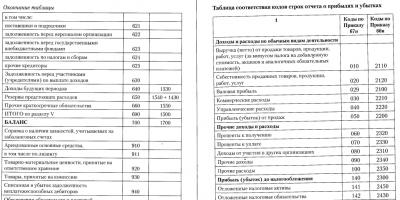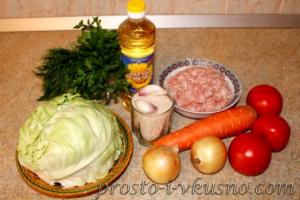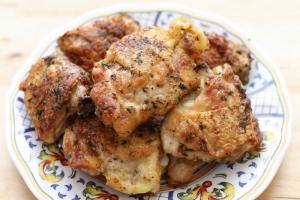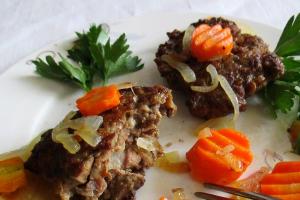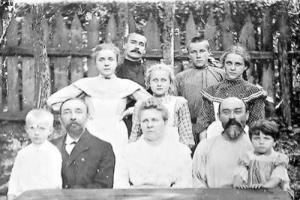Slide 1
Slide description:
Slide 2
Slide description:
Slide 3
Slide description:
Slide 4
Slide description:
Slide 5
Slide description:
Slide 6
Slide description:
Animal fats - beef and lard - are used for hot meat dishes and frying some types of flour products. Lamb lard is successfully used to prepare many dishes of Caucasian and Central Asian cuisine. Animal fats - beef and lard - are used for hot meat dishes and frying some types of flour products. Lamb lard is successfully used to prepare many dishes of Caucasian and Central Asian cuisine. Liquid fats, vegetable oils, are used in all cases where the recipe requires the use of non-solidifying fat. The use of a particular fat for different foods is often determined by its melting point. Thus, in dishes that are served only hot, refractory fats can be used. For those foods that are served both hot and cold, refractory fats are not suitable, since when they solidify they give an unpleasant aftertaste, as they say, “get cold on the lips.” For these dishes, it is advisable to use vegetable and cow oil, margarine, and lard. Despite the fact that margarine and lard also become dense when they harden, they quickly melt in the mouth and do not give the food a “greasy” taste.
Slide 7
Slide description:
Vegetable fats are extracted from the seeds of oilseed plants by pressing or extraction. The essence of the pressing process is to squeeze oil out of crushed seeds, from which most of the hard shell (peel) has been previously removed. Depending on the method of conducting the technological process, cold-pressed and hot-pressed oil are distinguished. During hot pressing, crushed seeds are preheated in roasters. Extraction consists of a series of sequential operations: cleaning, drying, removing the shell and grinding the seeds, extracting oil from them using special solvents and then removing the solvent from the oil. Vegetable oil is purified either by filtration or by exposure to alkalis. In the first case, the product is called unrefined, in the second, refined. The oil obtained by extraction is edible only in refined form. Refined vegetable oil is most suitable for frying, since particles of mucous and protein substances remaining in unrefined oil when fat is heated to a high temperature quickly decompose and can give the fried product a bitter taste and a specific unpleasant (“smoky”) odor.
Slide 8
Slide description:
Slide 9
Slide description:
Slide 10
Slide description:
Slide 11
Slide description:
Slide 12
Slide description:
Slide 13
Slide description:
Slide 14
Slide description:
Slide 15
Slide description:
Slide 16
Slide description:
Slide 17
Slide description:
Slide 18
Slide description:
Slide 19
Slide description:
Slide 20
Slide description:
Slide 21
Slide description:
Slide 25
Slide description:
Slide 26
Slide description:
Slide 27
Slide description:
The role of fats in nutrition is determined by their high calorie content and participation, together with proteins, in plastic processes. Fat that is part of cellular structures is often called protoplasmic or structural, in contrast to reserve fat, which is accumulated by the body in so-called fat depots. The role of fats in nutrition is determined by their high calorie content and participation, together with proteins, in plastic processes. Fat that is part of cellular structures is often called protoplasmic or structural, in contrast to reserve fat, which is accumulated by the body in so-called fat depots. In addition to their high calorie content, the biological value of fats is determined by the presence of fat-soluble vitamins (A, D, E) and polyunsaturated fatty acids. Vitamins A and D are found in animal fats. There are especially many of them in the liver of fish and marine animals; Vitamin E predominates in vegetable oils. Polyunsaturated fatty acids - linoleic and arachidonic - are essential, since their synthesis in the body is extremely limited. They play an important role in metabolism: their lack in nutrition negatively affects the functioning of the human body.





Based on the ability of fats to dissolve in certain solvents (low-boiling gasoline). The solvent extracts the oil from the extracted material, creating miscella (a solution of vegetable oil in the solvent). Impurities are removed from the miscella by filtration, and then the solvent is distilled off by heating under vacuum.

Mechanical - removal of suspended solids; sedimentation; filtration; Hydration - removal of protein and mucous substances; Neutralization - removal of free fatty acids. Bleaching is the removal of coloring matter. Deodorization – removal of traces of gasoline and aromatic substances.










CHURGING CREAM 1. Pasteurization of cream 2. Cooling to 2-8ºC 3. Maturing 4. Churning in butter producers CONVERSION OF HIGH FAT CREAM 1. Pasteurization of cream 2. Separation 3. Normalization for fat and moisture content. 4. Cooling 5. Conversion into oil in oil former.


Unsalted butter is made from pasteurized sour cream or sweet cream, 82.5% fat and 16% moisture. Salted butter comes in sweet cream and sour cream varieties. Produced with the addition of table salt (1%). Vologda butter is obtained from cream pasteurized at a temperature of 95-98°C.

Amateur oil contains 78% fat, 20% moisture. Peasant oil fat 72.5%, moisture 25%. Sandwich butter. Chocolate butter is made from natural cream with the addition of sugar, cocoa and vanillin. Honey oil is obtained with the addition of honey. Fruit oil is made with the addition of fruit and berry fillers (juices, extracts, jams) and sugar. Baby oil is prepared with the addition of sugar or powdered sugar.

Rendered milk fat with its own specific taste and aroma. The raw materials for its production are butter and cheese oil (produced from cream separated from whey), as well as butter stripping. The fat content in ghee is not less than 98%, moisture is not more than 1%.

The taste and smell of the oil are pure, characteristic of this type, without any foreign tastes or odors. Oil with fillers should have a pronounced taste and aroma of the added fillers. The consistency (at 10-12°C) of butter should be dense, homogeneous, the cut surface should be slightly shiny and dry in appearance, with the presence of single tiny drops of moisture; When melted, the ghee should be clear and without sediment. The color of the oil is from white to light yellow, uniform throughout the mass.

Bitter taste. Greasy. Feed flavors. Olive taste (taste of stale vegetable oil. Rancid taste. Yellowed edge. Crumbly consistency. Uneven color. Packaging defects. Oil with incorrect or unclear labeling; affected by mold inside; with foreign impurities; and melted oil with the presence of buttermilk or brine is not allowed for sale; with putrefactive, rancid, fishy and moldy taste and smell, as well as the taste and smell of petroleum products and chemicals; butter with fillers with foreign taste and smell, unusual for this type of oil, as well as with unexpressed taste and aroma of the introduced fillers.

Butter and ghee are produced by weight and packaged. For retail sale, the oil is packaged in briquettes wrapped in parchment or laminated foil of 100, 200, 250 g; Ghee is packaged in glass containers with a net weight of 450, 600 g; in tins of 350 and 2700 g. At a temperature not higher than 3°C and a relative humidity of not more than 80%, butter is stored from the date of packaging: 10 days. When storing oil, it is necessary to protect it from light and ensure air circulation.



Depending on the location of deposition, raw lard can be: subcutaneous, internal intermuscular. Internal fat has a high melting point and is located on the internal organs. The best fat is considered to be the fat of the omentum, as well as the fat located near the kidneys and heart. Fat removed from the stomach and intestines has a specific unpleasant odor.

DRY METHOD 1. Fatty raw materials are heated in boilers. 2. The floating fat is separated and filtered. The fat is shelf stable, but has a dark color and a specific smell of fried greaves. WET METHOD 1. Fat raw materials are heated in boilers with water. This prevents burning of raw materials. But the resulting broth is difficult to separate from the fat, which makes the fat less shelf-stable.






Collected from the surface of the broth when cooking sausages, smoked meats, offal, etc. The color of the fat is from white to dark yellow. Grayish and greenish shades are allowed. The smell and taste of greaves, broth, spices, smoked meats. The consistency is liquid, ointment-like or dense.

Packed in wooden or plywood stamped barrels weighing no more than 30 kg. The inside of the container is lined with parchment or film. For small packaging, cardboard, paper, glass, metal and polymer containers are used. Store at a temperature of 5 to 8°C without noticeable changes in quality for up to 6 months. Store in stores at a temperature of 04°C and a relative humidity of about 80% for no more than a month.


Margarine is a highly dispersed fat-water system that contains high-quality edible fats, milk, salt, sugar, emulsifiers and other components. It is used directly as food, for making sandwiches, as well as culinary, confectionery and bakery products.

Salomas. It is obtained through the process of hydrogenation of liquid vegetable and animal fats. Food lard can be vegetable or. Natural refined oils, coconut oil, animal fats. Additional raw materials: sugar, salt, cocoa powder, dyes, emulsifiers, flavorings, etc. Milk is used to enhance the taste.

Solid: MT is used in baking and culinary confectionery production; soft: MM are intended for direct consumption; liquid: MFA is used for frying and preparing baked goods in home cooking and public catering;

The taste and smell are pure with the taste and smell of introduced food flavoring and aromatic additives. The consistency for hard margarines is plastic, dense, homogeneous; for soft plastic, soft, fusible, homogeneous; for liquids, the consistency is homogeneous, liquid. The cut surface is shiny or slightly shiny, dry. Color from light yellow to yellow, uniform throughout the mass.

Greasy and rancid tastes. Clearly expressed taste of vegetable oil. Unclean taste. Drops of water appear on the margarine (tears) as a result of poor emulsification. A crumbly soft or hard consistency is formed when the technological regime for margarine production is violated.





Vegetable lard is produced from a mixture of vegetable lard (7580%) and natural vegetable oil (1525%). Frying fat is made from vegetable lard; it is possible to add lard from whale oil. Belarusian fat is obtained from a mixture of vegetable and whale lard (60%), vegetable oil (20%) and beef fat (20%).

Ukrainian fat is produced from a mixture of edible lard (vegetable and whale), vegetable oil and pork fat (30-40%). Oriental fat is obtained from a mixture of edible lard (vegetable and whale), vegetable oil and lamb fat (15%). Margaguseline is made from lard (40-70%), pork fat (20%) and vegetable oil (10-30%).

Color from white to light yellow. The taste and smell must correspond to the name of the fat. The consistency is solid and homogeneous. When melted, cooking fats should be transparent. Cooking fats contain at least 99.7% fat and no more than 0.3% moisture.

Packed in plywood or cardboard boxes weighing up to 30 kg. They are produced in small packaging in bags made of greaseproof polymer films or in the form of bars wrapped in parchment, grams each, as well as in cans of 0.5 and 1 kg. Cooking fats are stored at temperatures from 4 to 6°C for up to 12 months, at 14°C for 6 months, at 5–10°C for 3 months, and at 1118°C for up to 1 month. Relative humidity should be 80%.

1 slide

2 slide
Lesson plan: Fats in nature. 2. Classification of fats. 3. Composition and structure of fats. 4. Biological role in the body.

3 slide
FATS IN NATURE. All animal and plant cells contain lipids. The most common of lipids are fats. The fat content in cells is usually low: 5–15% of dry matter, and in adipose tissue cells the amount of fat increases to 90%.

4 slide

5 slide
And in animals and humans - in the subcutaneous layer, between muscle fibers and in the abdominal cavity.

6 slide

7 slide

8 slide
PHYSICAL PROPERTIES: All fats are lighter than water, insoluble in water, highly soluble in organic solvents. French chemists played a major role in establishing the composition and structure of fats. In 1854, M. Berthelot carried out the synthesis of fats. In the beginning. XIX century M. Chevrel Carried out the hydrolysis of fats.

Slide 9
FATS - ESTERS FORMED BY GLYCEROL AND HIGHER CARBOXYLIC ACIDS. CH2 – O – C – R1 CH – O – C – R2 CH2 – O – C – R3 // // // O O O Carboxylic acid residues glycerin

10 slide
BIOLOGICAL ROLE OF FATS. FUNCTIONS OF FATS: 1.Energy. During the breakdown of 1 g of fats into CO2 and H2O, a large amount of energy is released - 38.9 kJ. Fats are the main reserve fuel; they are called the “energy depot” of living organisms. The released energy is necessary for the life of the organism.

11 slide
2. Construction. Fats are structural elements of cell membranes and cellular organelles.

12 slide
3. Regulatory. The formation of some lipids precedes the synthesis of a number of hormones, for example, the adrenal cortex.

Slide 13
4. Spare. Fats are storage substances in the form of which metabolic fuel is deposited. It is known that a camel can live without drinking for up to one and a half months. At this time, it “extracts” water due to the gradual oxidation of fat reserves contained in the humps, which can reach up to 120 kg.

Slide 14
5. Protective. Due to their well-pronounced thermal insulating properties, fats retain heat in the body, especially in marine and polar animals. In the form of a fat pad they protect the body and organs of animals from mechanical damage and serve as a fatty lubricant for the skin.

15 slide
Reinforcement test. Which product should be given to a tired marathon runner to maintain strength? a) a piece of sugar, b) a piece of meat, c) a piece of lard 2. A larger amount of E is released when 1g is broken down: a) fat, b) glucose, c) protein 3. In what substance do fats dissolve? a) alcohol, b) water, c) hydrochloric acid 4. The ability of camels to tolerate thirst well is explained by the fact that fats: a) retain water in the body b) release water during oxidation c) create a heat-insulating layer that reduces evaporation.
Chemistry presentation on the topic: Fats. Completed by 10th grade students: Ekaterina Zadorogina, Anna Koshkina, Olga Sizonova, Irina Petrova. Contents: Determination of fats. Classification of fats. Animal fats Vegetable oils Composition of fats. Acids that make up fats. Properties of fats. Chemical properties Physical properties The history of the discovery of the composition of fats and their synthesis in the laboratory. Use of fats. Definition of fats Fats are natural compounds that are esters of the trihydric alcohol glycerol and fatty acids. The common name for these compounds is triglycerides. The composition and structure of fats can be reflected by the general formula: O H2C – O – C R1 O HC – O – C R2 O H2C – O – C R3 Here R are hydrocarbon radicals, which can be either the same or different. Classification of fats. Saturated animal fats (solid) unsaturated vegetable fats (oils; liquid) Animal fats Animal fats (mainly of dense consistency) are much richer in saturated fatty acids (butyric, palmitic...) and have a high melting point. The source of animal fats is lard, lard, butter, sour cream, cream, cheeses. Vegetable oils Vegetable fats, as a rule, remain liquid under normal conditions, contain mainly unsaturated fatty acids (linoleic, linolenic, arachidonic) and have a low melting point. The source of vegetable fats are vegetable oils, nuts, soybeans, beans, oatmeal, buckwheat and others. Composition of fats. The composition of fats corresponds to the general formula: CH2-O-C(O)-R1 | CH-O-C(O)-R2 | CH2-O-C(O)-R3, where R1, R2 and R3 are radicals of (sometimes different) fatty acids. Natural fats contain three acid radicals that have an unbranched structure and, as a rule, an even number of carbon atoms (the content of “odd” acid radicals in fats is usually less than 0.1%). Acids included in fats: Myristic acid C13H27COOH Palmitic acid CH3(CH2)14COOH Stearic acid C17H35COOH Oleic acid CH3(CH2)7CH=CH(CH2)7COOH Linoleic CH3(CH2)3–(CH2CH=CH)2(CH2)7COOH. Linolenic CH3(CH2CH CH)3(CH2)7COOH Chemical properties of fats Saponification. Saponification of fats is their breakdown into free fatty acids and glycerol. For saponification, alkali solutions and metal oxides are used; this produces salts of fatty acids and glycerol: C3H5(OCOR)3 + 3NaOH = C3H5(OH)3 + 3RCOO where R is the fatty acid residue. Salts of fatty acids formed by alkali and alkaline earth metals are called soaps, and lead salts are called plasters. By shaking fatty oils with an ammonia solution, a volatile ointment is obtained - Linimentum ammoniatum; This is the same soap suspended in excess fatty oil. Rancidity. When fats are stored for a long time, a complex chemical process called rancidity occurs. The reaction occurs in the light with access to air and moisture and, probably, not without the participation of appropriate microorganisms; fats and oils are partly oxidized (by adding oxygen from the air), and partly undergo a saponification process, breaking down into glycerol and free acids. In this case, an unpleasant odor, an irritating bitter taste and an sour reaction appear. Drying of fats is a complex physical and chemical process in which, under the influence of atmospheric oxygen, their oxidation occurs, followed by condensation and polymerization. This process is associated with the presence of linoleic and linolenic acids in oils. Fats containing these acids, when spread in a thin layer, gradually turn into a transparent film, insoluble in either ether or gasoline and called oxin. Oils in which linoleic acid predominates produce soft films and are called semi-drying; oils consisting predominantly of glycerides of linolenic and isolinoleic acids form solid films and are called drying. Hydrogenation of fats is the addition of hydrogen at the site of double bonds. Fats containing unsaturated fatty acids can add two hydrogen atoms at the double bond, turning into the corresponding saturated acids. For example, oleic, linoleic and linolenic acids, when the double bonds are saturated, are converted into stearic acid. In this case, the liquid fat thickens. Our widely developed production of hydrogenated fats is based on this reaction. Hydrogenated (compacted) fats are used in the food industry in the form of margarine, and are also used in the production of ointments, pastes, and creams. Physical properties of fats. Oily to the touch; applied to paper, give a characteristic stain. Natural fats and fatty oils are colored yellowish, less often greenish due to the presence of chlorophyll, and even less often red-orange or another color depending on the presence of certain coloring substances. Fresh fats and oils have a specific, usually pleasant, smell and taste due to the admixture of various volatile substances. All fats are lighter than water. They are completely insoluble in water, slightly soluble in alcohol (with the exception of castor oil), somewhat more soluble in boiling alcohol, and soluble in all proportions in ether, chloroform and carbon disulfide. Fats and oils are not volatile and cannot be distilled without decomposition. When heated strongly, fats begin to decompose and release the eye-irritating aldehyde acrolein, which is a decomposition product of glycerol and has a very unpleasant pungent odor. Fats and fatty oils do not ignite at ordinary temperatures, but with strong heat they can burn with a bright flame. They conduct heat and electricity poorly. The history of the discovery of the composition of fats and their synthesis in the laboratory. Elemental analysis of fats was carried out in the 19th century. A. Lavoisier In 1779, K. Scheele established that the composition of fats includes glycerin. In 1808, M. E. Chevrel established that soap is the sodium salt of a higher fatty acid. Stearic, oleic, and caproic acids were obtained for the first time. He showed that fats consist of glycerol and fatty acids, and this is not just a mixture, but a compound that, by adding water, breaks down into glycerol and acids. Chevreul, together with J. Gay-Lussac, proposed a method for producing stearin suppositories. The synthesis of fats was carried out in the 1850s by Marcelin Berthelot by heating a mixture of glycerol and fatty acids in sealed glass tubes. Phospholipids were isolated by M. Gobley in 1847, and then obtained in a purer form by F.A. Hoppe-Seyler in 1877. Use of fats. Food industry. Perfumes and cosmetics. Getting soap. SMC (synthetic detergents) Obtaining glycerin. Pharmaceuticals Production of lubricants Literature General biology 10-11, V.B. Zakharov, M. Bustard, 2002 Open lessons in chemistry VIII-XI classes / V.G. Denisova, Volgograd, 2002. Chemistry 10th grade, O.S. Gabrielyan, M. Bustard 2002 I’m going to class. Chemistry grades 10-11.M. “First of September”, 2003
Lesson topic: Fats Among esters, a special place is occupied by natural compounds - fats. Extracted from various sources 600 various types of fats, of which - 420 of plant origin... and more than 180 of animal origin. Fats is a mixture of esters of glycerol and higher carboxylic acids with a straight carbon chain. General fat formula:
- CH2–O–C–R
- | Oh
- CH – O – C – R"
- | Oh
- CH2– O – C – R"‘ The general name of such compounds is triglycerides
- CH2Br–CHBr–CH2Br+ 3C17H35COOAg ->
- -> CH2(OOCC17H35)–CH(OOCC17H35)–CH2(OOCC17H35) +
- + 3AgBr.
- Liquid fats
- (oils)
- educated
- unsaturated acids
- Solid fats
- educated
- saturated acids
- Hydrolysis of fats under the influence of water is reversible:
- H2C – O-H
- NS – O-N
- H2C – O-H
- С17Н35СООНa
- С17Н33СООНa
- С17Н31СООНa
- Progress of the experiment:
- 1. In a porcelain cup, heated the mixture obtained by adding a mixture of 10 ml of ethyl alcohol and 10 ml of alkali solution to 10 g of rendered lard for 10 minutes in a water bath, stirring occasionally. 2. Cooled the solution and added 20-25 ml of saturated sodium chloride solution. 3. The product was carefully dried with filter paper.
- Discoloration of bromine water,
- hydrogenation (+H2),
- discoloration of the KMnO4 solution.
- 1 g of fat with complete oxidation (it occurs in cells with the participation of oxygen) provides 9.5 kcal (about 40 kJ) of energy, which is almost twice as much as can be obtained from proteins or carbohydrates
- It is known that “ships of the desert” camels can go without drinking for a long time. At the same time, water enters their body from fat deposits in the hump. A camel's fat reserves can reach 120 kg. If we assume that all camel fat consists of tristearate C57H110O6 - an ester of glycerol and the most common fatty acid - stearic acid, determine the mass of water resulting from the complete oxidation of all fat.


